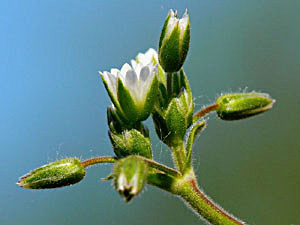
natural herbs
Common Mouse-Ear Chickweed
Cerastium holosteoides

Herb: Common Mouse-Ear Chickweed
Latin name: Cerastium holosteoides
Synonyms: Cerastium triviale
Family: Caryophyllaceae (Pink Family, Starwort Family)
Edible parts of Common Mouse-Ear Chickweed:
Leaves and young shoots. This report refers to the sub-species C. holosteoides glandulosum. Koch.Description of the plant:

Plant:
Annual/Perennial
Flowering:
April toSeptember
Habitat of the herb:
Mostly in wet places. Grassland, shingle, dunes, waysides, waste places and cultivated ground.Propagation of Common Mouse-Ear Chickweed:
Seed - we have no information on this species but suggest sowing the seed in spring in a cold frame. When they are large enough to handle, prick the seedlings out into individual pots and plant them out into their permanent positions in the summer. Division in spring might be possible.Cultivation of the herb:
Mostly in wet places. Grassland, shingle, dunes, waysides, waste places and cultivated ground.Medicinal use of Common Mouse-Ear Chickweed:
None knownKnown hazards of Cerastium holosteoides:
None knownPlant information taken from the Plants For A Future.
